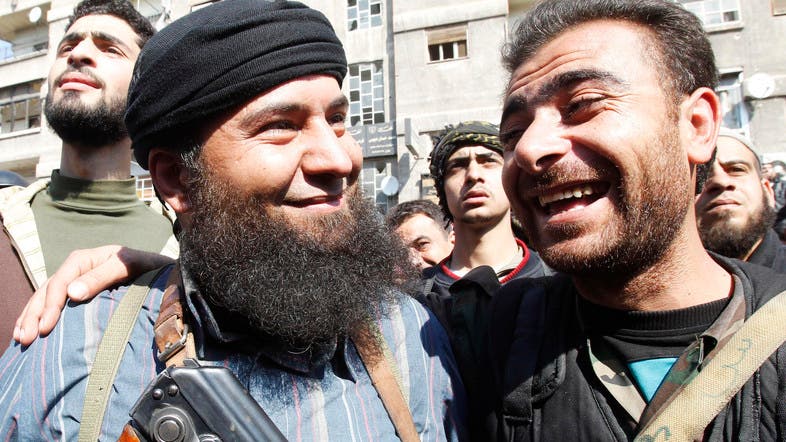It was less than 20 years ago, when Hussam Zayade climbed with his friends the old walls of Daraya’s Ottoman era mosque in Syria. “We read the old scriptures on the inner dome, as if we were archaeologists, looking for a discovery,” he recalls. The Goddess of Love, the Roman ruins, the Greek and Orthodox churches, and the vineyards where he spent his childhood, are all now memories.
“70 percent of the town, besieged since 14 months, is nowdestroyed,” says Alaa, a Daraya opposition activist, who left three months ago.
The town’s once 250,000 residents have dwindled to a mere 7,000, the majority of whom are civilians; the ratio of fighters to civilians is now 5 to 2.
Daraya had joined the revolution early on and became famous for handing flowers to soldiers at peaceful demonstrations; but the protests were violently crushed. One of its key activists, Ghayath Matar, died from torture, and is now hailed as a revolutionary symbol. In early 2012, the Free Syrian Army (FSA) started operating in Daraya; the regime acted quickly. The Syrian Army heavily shelled the town, then committed a massacre in August that year, leaving hundreds, including women and children, dead. Many thousands fled, while the fighting and destruction worsened.
New strategy to ‘eliminate threats’
Today, nearly three years since the revolution, the battle for Daraya is at the heart of a new regime strategy to eliminate any possible threat to the regime’s grip on the capital. The regime is dispatching the town’s Mayor to negotiate a truce with the revolutionary Local Council. The negotiations started a month ago, and the regime’s air force has intensified its bombing campaign, using explosive barrels, to mount pressure on the remaining residents and fighters. “20 barrels a day are dropped on Daraya,” Zayade said, “a day before a designated meeting, the regime dropped 40.”
In August last year, rebel fighters in Maadamiya, an adjacent suburb, signed a truce with regime forces; the agreement followed a long devastating siege and overwhelming destruction. Last month, Barzeh, a Damascus neighborhood, followed suit, ending almost two years of fighting in the capital.
“In Barzeh, the FSA is cooperating with the regime, both troops are seen patrolling the streets. It is unbelievable,” says Hassan Jana, a member of Daraya’s local revolutionary council. Like Daraya, the destruction in Barzeh and Maadamiya has raised eyebrows.
Following the truce in both areas, the regime allowed a free flow of people and goods, and released FSA fighters in less than 24 hours, according to various local reports. This new “soft approach,” backed by Russia, remains confined to Damascus, leading many to believe the regime is trying to focus on the Aleppo and Qalamoun fronts, in Northern and Western Syria, respectively.
“This is a sly regime, we do not trust it,” says Alaa, who is strongly opposed to the truce. He believes the regime is pushing hard for the agreement to relocate troops; “this amounts to treason, and we will not accept it.”
A lucrative truce?
To make the truce more attractive, the regime is offering therelease of local activists and fighters, reinstating basic services like electricity and water, partial rebuilding, and the return of refugees. Through the return of refugees, weary activists believe, the regime aims to reinstate the old order of fear.
The collective punishment inflicted in Daraya, Barzeh and Maadamiya, will serve the regime well, they believe, as the returning refugees will resist any form of dissent or opposition. “The regime is now reaping the benefits of its collective punishment policy,” Alaa says, “it is what it knows best since the massacre of Hama in 1982; they plant destruction, and harvest fear.”
Alaa stayed during much of the fighting, along with a friend and two of his uncles; he left in Oct. 2012 for a few days to check upon his parents. The trip saved his life, as his house was shelled, killing his two uncle and best friend, Mohamad Quraytem.

In Maadamiya, the FSA surrendered its heavy weapons, while the regime forces allowed food and essential supplies into the besieged area. “The regime besieged the towns, cutting all aid, then heavily pounded them for more than year with artillery, air raids, while deploying snipers,” Hasan, another Daraya activist who lost his home, many family members and friends in the fighting.
Fractures with the FSA
Many are finding the deals between the FSA and the Syrian army surreal. “Even genuine Marijuana would fail to help you understand this situation,” a Syrian activist wrote on Facebook, describing the images of both armies together in Bebila, a town on Damascus’s outskirts, where a truce was agreed. Some residents demonstrated against the agreement, brokered by local officials.
Daraya is not there yet, but for those hoping for a longer period of resistance, the signs are not good. Fractures within the remaining FSA forces are surfacing. Last Thursday, six members of the local council, two activists, and an FSA commander were kidnapped for hours after midnight. According to the local council’s statement, the kidnapping “targeted those who reject the truce’s terms.” They were beaten up, tortured and then released.
The truce is underway but many activists and fighters, like Alaa, remain fiercely opposed to what they perceive as “surrender” and “treason.”
“The truce,” he says, “is a betrayal of our martyrs and their sacrifices”. If and when it is signed, Alaa insists he will not return again.
“It will no longer be my town.”
__________
Mohanad Hage Ali is a journalist based in London and Beirut. He can be found on Twitter: @MohanadHageAli
















Comments About This Article
Please fill the fields below.